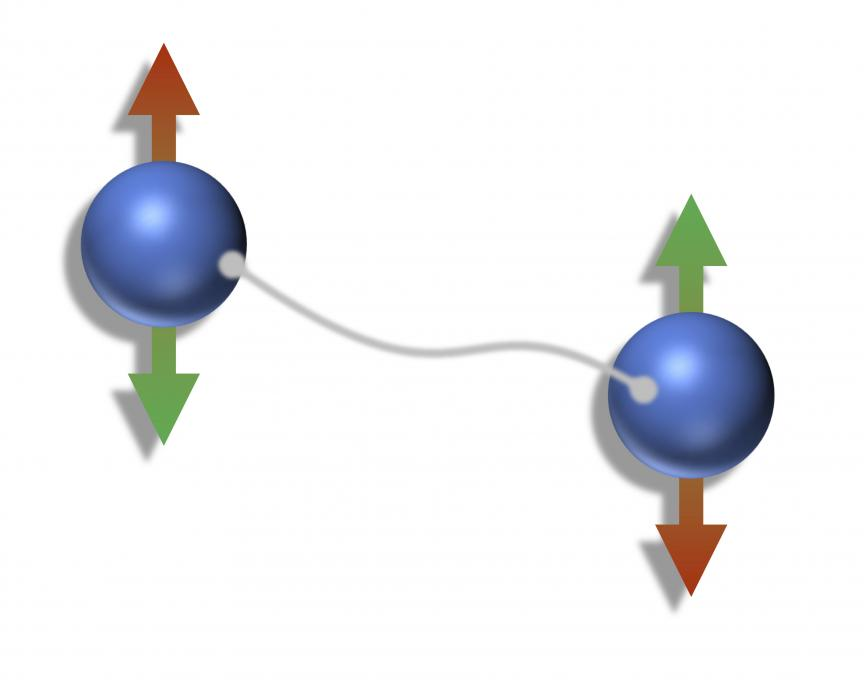Mar 5 2020
A group of Physicists from Rutgers University has identified the strange behavior of electrons in a ferromagnet. This discovery could ultimately lead to the development of high-temperature superconductivity.
 Entangled electrons in quantum mechanics can be visualized as connected by an invisible thread, so an “up-spin” on the left electron (red) forces the other electron to be “spin-down” (red) and vice-versa (green). Image Credit: Yashar Komijani.
Entangled electrons in quantum mechanics can be visualized as connected by an invisible thread, so an “up-spin” on the left electron (red) forces the other electron to be “spin-down” (red) and vice-versa (green). Image Credit: Yashar Komijani.
The study of the unusual ferromagnetic material, co-authored by Rutgers University, has been reported recently in the Nature journal.
The Rutgers Center for Materials Theory, a pioneer in this field, investigates “quantum phase transitions.” Phase transitions, for example, those that occur during the melting of ice, necessitate heat to agitate the atoms and melt the ice crystals. Quantum phase transitions are triggered by the agitation of electrons and atoms due to fluctuations that never stop even at low temperatures.
It is possible to achieve a quantum phase transition by tuning a material to improve quantum fluctuations, by exposing the material to intense pressure at a near absolute zero temperature or by applying a magnetic field. In some cases of quantum phase transitions, the quantum fluctuations turn out to be endlessly intense, thereby creating a “quantum critical point.”
These peculiar states of matter grab huge attention since they have the tendency to form superconductors. It can be considered as an electronic stem cell—a kind of matter with the ability to convert itself in several ways.
In the strange realm of quantum mechanics, “entanglement” enables something to be present in two different places or states simultaneously. A cat that is alive and dead at the same time is an example of entanglement, and it was a famous thought experiment proposed by Erwin Schrödinger, an Austrian physicist.
Within materials that include electrons moving through them, entanglement is generally caused by the spin of electrons, which can be up and down at the same time. Essentially, in quantum materials, only the electrons present next to each other are entangled. However, in the case of a quantum critical point, the entanglement patterns may vary suddenly, spreading out all over the material and converting it. This enables electrons, even distant ones, to get entangled.
Quantum entanglement cannot possibly be investigated in ferromagnets since the electrons moving within them align in a single direction rather than spinning up and down.
However, physicists have discovered that the ferromagnetism in “Cerge,” (CeRh6Ge4) a ferromagnet, should potentially have a higher degree of entanglement with electrons that spin up and down and are linked with each other. Such a property has not been observed in ferromagnets earlier.
We believe our work, connecting entanglement with the strange metal and ferromagnets, provides important clues for our efforts to understand superconductors that work at room temperature.
Piers Coleman, Study Co-Author and Professor, Department of Physics and Astronomy, School of Arts and Sciences, Rutgers University–New Brunswick
“As we learn to understand how nature controls entanglement in matter, we hope we’ll develop the skills to control quantum entanglement inside quantum computers and to design and develop new kinds of quantum matter useful for technology,” added Coleman.
The Rutgers physicists have applied some of the study outcomes to put forward a new theory for a class of iron-based superconductors discovered nearly a decade ago.
If we are right, these systems, like ferromagnets, are driven by forces that like to align electrons.
Piers Coleman, Study Co-Author and Professor, Department of Physics and Astronomy, School of Arts and Sciences, Rutgers University–New Brunswick
One of the three co-lead authors of the study is Yashar Komijani, a Rutgers post-doctoral associate. Researchers from the Max Planck Institute for Chemical Physics of Solids in Germany and Nanjing and Zhejiang universities in China took part in this study.